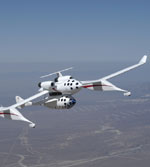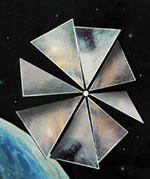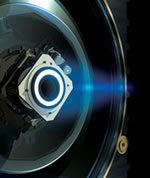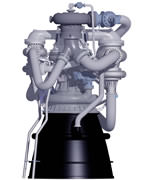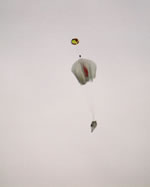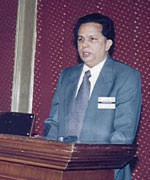
Image credit: ISRO
Mr. G Madhavan Nair has been appointed as the new Chairman of the Indian Space Research Organization (ISRO). Previous to this new position, Nair was the Director of Vikram Sarabhai Space Centre, and has been involved in the agency since 1967 when he was first hired at the Thumba Equatorial Rocket Launching Station. His predecessor, Dr K Kasturirangan, left the position after he was nominated for India’s Upper House of Parliament.
The Appointments Committee of the Cabinet has appointed Mr G Madhavan Nair as Secretary, Department of Space, Chairman Space Commission and Chairman, ISRO. Mr Madhavan Nair, who was Director, Vikram Sarabhai Space Centre (VSSC), Thiruvananthapuram, was holding additional charge of these posts since September 1, 2003 after Dr K Kasturirangan relinquished the office consequent to the President of India nominating him as Member of Rajya Sabha (Upper House of Parliament).
Mr Madhavan Nair is a leading technologist in the field of Rocket Systems. He has made significant contributions to the development of multistage Satellite Launch Vehicles for the Indian space programme. As Director, VSSC, he has led research and development in the area of satellite launch vehicles for orbiting spacecraft for remote sensing and communications.
After graduating in Engineering from Kerala University in 1966, Mr Madhavan Nair underwent training at Bhabha Atomic Research Center (BARC), Mumbai, and joined Thumba Equatorial Rocket Launching Station (TERLS) in 1967. Since then, he has held various positions posting illustrious milestones on his way to the present position. He made impressive contributions to the first Indian Satellite Launch Vehicle, SLV-3. Subsequently, as Project Director, he brought to fruition the development of India’s first operational Satellite Launch Vehicle, PSLV. With six successful launches so far, PSLV has convincingly demonstrated its reliability for not only launching multiple satellites including placing them in different orbits in a single launch but also its capability to place satellites in Geo-synchronous Transfer Orbit (GTO). PSLV is also proposed for launching India’s unmanned lunar craft under Chandrayaan-1 mission. Mr Madhavan Nair, also contributed to the indigenous development of cryogenic technology and as Dire
ctor, Liquid Propulsion Systems Centre during 1995-99, he gave concrete shape for the vital infrastructure for its development.
Mr Madhavan Nair took over as the Director of VSSC in 1999 and in the following two years led the successful flight of GSLV in the very first attempt followed by another successful flight in May 2003. GSLV has since been commissioned into operational service for launching 2000 kg class satellites into GTO.
Mr Madhavan Nair has been the leader of the Indian delegation to the United Nations Committee on Peaceful Uses of Outer Space (UN-COPUOS). He has received several prestigious awards including Shri Om Prakash Bhasin Award, Swadeshi Sastra Puraskar Award, FIE Foundation Award and Vikram Sarabhai Memorial Gold Medal of ISCA. He was conferred ‘Padma Bhushan’ by the President of India in 1998.
The outgoing Chairman of ISRO, Dr K Kasturirangan, saw during his tenure of nearly a decade, the Indian space programme witnessing several major milestones including the commissioning of India’s prestigious launch vehicle, the Polar Satellite Launch Vehicle (PSLV) and more recently, the commissioning of all important Geo-synchronous Satellite Launch Vehicle (GSLV). Further, the world’s best civilian remote sensing satellites, IRS-1C and 1D, experimental remote sensing satellites, IRS-P2 and IRS-P3, besides
an exclusive ocean observation satellite IRS-P4 were launched. A 1-m spatial resolution experimental satellite, TES, was also built and launched during his tenure. He also saw the launching of second generation INSAT satellites that vastly enhanced the capacity of INSAT system for telecommunication, television broadcasting and meteorology. Three satellites under the third generation series, INSAT-3A, INSAT-3B, and INSAT-3C were also launched besides an exclusive meteorological satellite, KALPANA-1. He chaired some of the prestigious international committees, such as, the International Committee on Earth Observation Satellites (CEOS), Panel for Space Research in Developing countries of COSPAR/ICSU, and the committee meeting at senior official level of UN-ESCAP, that led to the adoption of the “Delhi Declaration” by the Ministers of the region (1999-2000).
Dr B N Suresh is the new Director of VSSC. Dr B N Suresh, Outstanding Scientist at ISRO’s Vikram Sarabhai Space Centre (VSSC), Thiruvananthapuram, has been appointed as the Director of the Centre and he took over charge on September 20, 2003 from Mr Madhavan Nair. Dr Suresh joined ISRO in July 1969 and is an expert in control and guidance systems. He has made significant contributions to the design and development of all satellite launch vehicles of ISRO – SLV-3, ASLV, PSLV and GSLV.
Original Source: ISRO News Release

